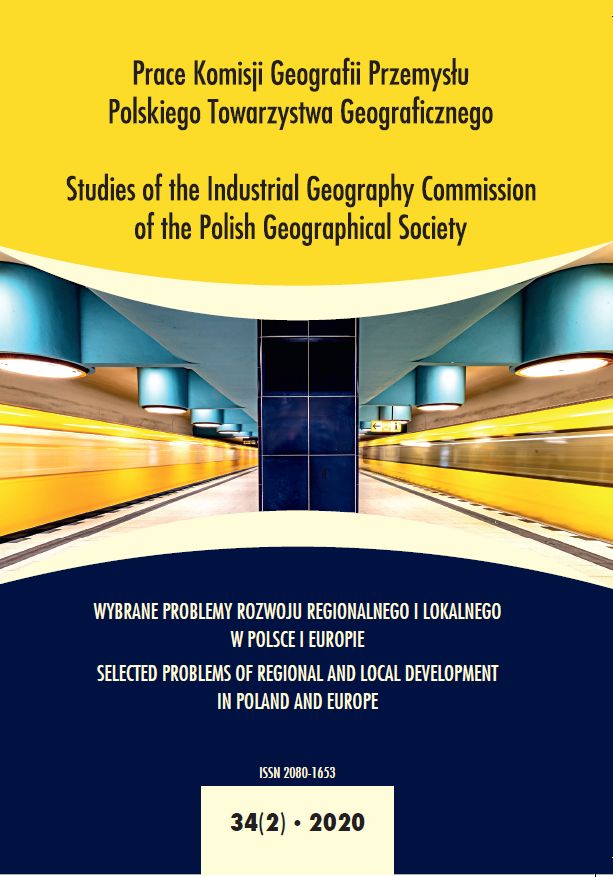Intra-Regional Disparities in the Distribution of Business Environment Institutions Based on the Example of Dolnośląskie Voivodeship in Poland
DOI:
https://doi.org/10.24917/20801653.342.7Keywords:
business environment institutions, business support services, Dolnośląskie Voivodeship;, GIS multi‑layer analysis, intra‑regional disparitiesAbstract
Business environment institutions (BEIs) play an important role in the development of entrepreneurship
in their area of influence. Actual development strategies of administrative -territorial units and regional operational programmes support the creation of these institutions. In practice, however, with the
emergence of subsequent BEIs, increase spatial disparities in their location. The aim of the study was to assess the spatial accessibility of existing business environment institutions in the Dolnośląske Voivodeship.
On the basis of collected data on existing BEIs, distribution of population and enterprises, GIS multi -layer
analysis was performed, including transport network, nature restrictions. The conducted research shows
significant spatial disparities in the location of BEIs. On the territory of the voivodeship there are several
spatial concentrations of BEIs, as well as numerous areas with low and very low accessibility in relation to
the existing settlement network. In case of further lack of BEIs location plan on a regional scale, the existing
disparities in their location will increase, and thus the chances of entrepreneurship development in numerous areas with low accessibility to business support services will decrease. Due to the complexity of the issues undertaken, the findings in the article are of a directional nature and constitute a starting point for further in-depth research, inter alia designation of areas predisposed for the location of new BEIs.
Downloads
Metrics
References
Dołzbłasz, S. (2009). Instytucje otoczenia biznesu oraz jednostki B+R na obszarze województwa dolnośląskiego. W: Endo- i egzogeniczne determinanty obszarów wzrostu i stagnacji w województwie dolnośląskim w kontekście Dolnośląskiej strategii innowacji. Wrocław: Dolnośląska Agencja Współpracy Gospodarczej, Urząd Marszałkowski Województwa Dolnośląskiego.
Gasidło, K. (1995). Parki Technologiczne. Próba analizy przestrzenno‑funkcjonalnej. Zeszyty Naukowe Politechniki Śląskiej. Architektura, 26.
GUS (2019, 19 grudnia). Bank danych lokalnych. Pozyskano z https://bdl.stat.gov.pl
Hołub‑Iwan, J., Olczak, A.B., Cheba, K. (2012). Benchmarking parków technologicznych w Polsce. Warszawa: Polska Agencja Rozwoju Przedsiębiorczości.
Instytucje otoczenia biznesu (2019, 8 grudnia). Wrocław: Urząd Marszałkowski Województwa Dolnośląskiego. Pozyskano z http://www.umwd.dolnyslask.pl/gospodarka/innowacje/instytucje-otoczenia-biznesu
Kornecki, J., Kowalczyk, A. (red.) (2010). Badanie potencjału dolnośląskich organizacji otoczenia biznesu w zakresie świadczenia usług proinnowacyjnych. Raport 2010. Wrocław: ARGI.
Ładysz, J. (2014). Spójność terytorialna Unii Europejskiej a transgraniczny rozwój zintegrowany. W: J. Potocki, J. Ładysz (red.). Gospodarka Przestrzenna. Dylematy i wyzwania współczesności. Prace Naukowe Uniwersytetu Ekonomicznego we Wrocławiu, 339.
Mapa specjalnych stref ekonomicznych (2019, 2 grudnia). Pozyskano z http://sse.mapa.info.pl/
Pisano, G.P., Shih, W.C. (2009). Restoring American Competitiveness. Harvard Business Review, July–August, 1–14.
Polska Agencja Rozwoju Przedsiębiorczości (PARP) (2014). Ośrodki innowacji w Polsce (z uwzględnieniem inkubatorów przedsiębiorczości). Raport 2014. Warszawa.
PORT – Polski Ośrodek Rozwoju Technologii (2019, 19 grudnia). Sieć badawcza Łukasiewicz. Pozyskano z https://www.port.org.pl/pl/kampus-prace/
Projekt Planu zagospodarowania przestrzennego województwa dolnośląskiego (2018). Wrocław: Instytut Rozwoju Terytorialnego.
Ramy strategiczne na rzecz inteligentnych specjalizacji Dolnego Śląska (2015). Załącznik do Regionalnej strategii innowacji dla województwa dolnośląskiego na lata 2011–2020. Wrocław: Dolnośląska Instytucja Pośrednicząca.
Regionalna strategia innowacji dla województwa dolnośląskiego na lata 2011–2020 (2011, 30 sierpnia). Uchwała nr 1149/IV/11 Zarządu Województwa Dolnośląskiego.
Stryjakiewicz, T. (1999). Adaptacja przestrzenna przemysłu w Polsce w warunkach transformacji. Poznań: Wydawnictwo Naukowe Uniwersytetu im. Adama Mickiewicza w Poznaniu.
Downloads
Published
How to Cite
Issue
Section
License
Articles are published under the terms of the Creative Commons License (CC BY-ND 4.0; Attribution– NoDerivs).

